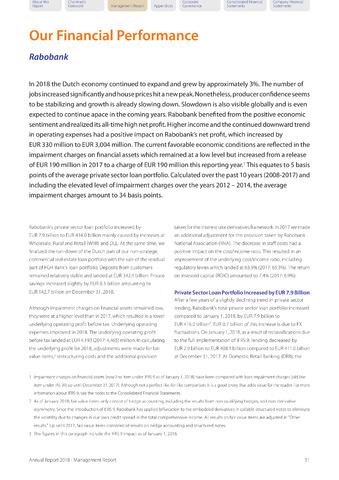Our Financial Performance
Rabobank
In 2018 the Dutch economy continued to expand and grew by approximately 3%. The number of
jobs increased significantly and house prices hit a new peak. Nonetheless, producer confidence seems
to be stabilizing and growth is already slowing down. Slowdown is also visible globally and is even
expected to continue apace in the coming years. Rabobank benefited from the positive economic
sentiment and realized its all-time high net profit. Higher income and the continued downward trend
in operating expenses had a positive impact on Rabobank's net profit, which increased by
EUR 330 million to EUR 3,004 million. The current favorable economic conditions are reflected in the
impairment charges on financial assets which remained at a low level but increased from a release
of EUR 190 million in 2017 to a charge of EUR 190 million this reporting year.1 This equates to 5 basis
points of the average private sector loan portfolio. Calculated over the past 10 years (2008-2017) and
including the elevated level of impairment charges over the years 2012 - 2014, the average
impairment charges amount to 34 basis points.
About this
Report
Chairman's
Foreword
Corporate
Management Report Appendices Governance
Consolidated Financial Company Financial
Statements Statements
Rabobank's private sector loan portfolio increased by
EUR 7.9 billion to EUR 416.0 billion mainly caused by increases at
Wholesale, Rural and Retail (WRR) and DLL. At the same time, we
finalized the run-down of the Dutch part of our non-strategic
commercial real-estate loan portfolio with the sale of the residual
part of FGH Bank's loan portfolio. Deposits from customers
remained relatively stable and landed at EUR 342.4 billion. Private
savings increased slightly by EUR 0.3 billion amounting to
EUR 142.7 billion on December 31, 2018.
Although impairment charges on financial assets remained low,
they were at a higher level than in 2017, which resulted in a lower
underlying operating profit before tax. Underlying operating
expenses improved in 2018. The underlying operating profit
before tax landed at EUR 4,193 (2017:4,465) million. In calculating
the underlying profit for 2018, adjustments were made for fair
value items,2 restructuring costs and the additional provision
taken for the interest rate derivatives framework. In 2017 we made
an additional adjustment for the provision taken by Rabobank
National Association (RNA). The decrease in staff costs had a
positive impact on the cost/income ratio. This resulted in an
improvement of the underlying cost/income ratio, including
regulatory levies which landed at 63.9% (2017:65.3%). The return
on invested capital (ROIC) amounted to 7.4% (2017: 6.9%).
Private Sector Loan Portfolio Increased by EUR 7.9 Billion
After a few years of a slightly declining trend in private sector
lending, Rabobank's total private sector loan portfolio increased
compared to January 1, 2018, by EUR 7.9 billion to
EUR 416.0 billion3. EUR 0.7 billion of this increase is due to FX
fluctuations. On January 12018, as a result of reclassifications due
to the full implementation of IFRS 9, lending decreased by
EUR 2.9 billion to EUR 408.1 billion compared to EUR 411.0 billion
at December 31, 2017. At Domestic Retail Banking (DRB), the
1 Impairment charges on financial assets (new line item under IFRS 9 as of January 1,2018) have been compared with loan impairment charges (old line
item under IAS 39; up until December 31,2017). Although nota perfect like-for-like comparison, it is a good proxy that adds value for the reader. For more
information about IFRS 9, see the notes to the Consolidated Financial Statements.
2 As of January 2018, fair value items only consist of hedge accounting, including the results from non-qualifying hedges, and non-derivative
asymmetry. Since the introduction of IFRS 9, Rabobank has applied bifurcation to the embedded derivatives in callable structured notes to eliminate
the volatility due to changes in our own credit spread in the total comprehensive income. All results on fair value items are adjusted in "Other
results." Up until 2017, fair value items consisted of results on hedge accounting and structured notes.
3 The figures in this paragraph include the IFRS 9 impact as of January 1,2018.
Annual Report 2018 - Management Report
51

